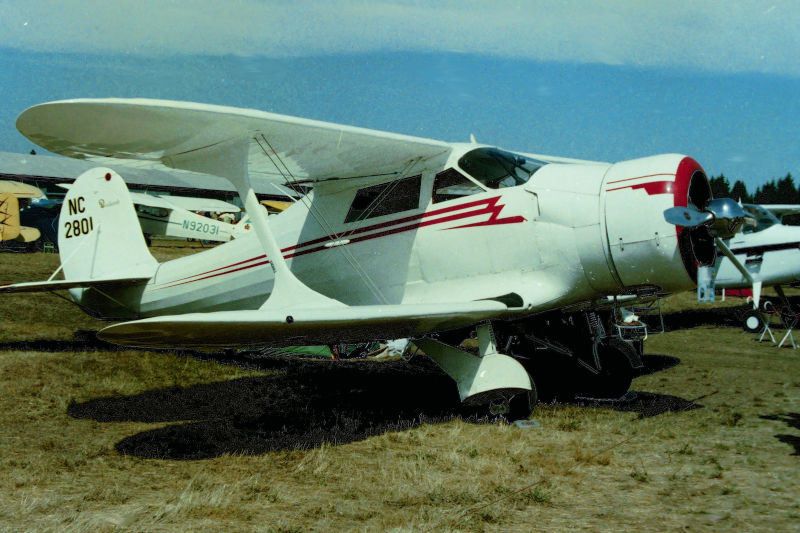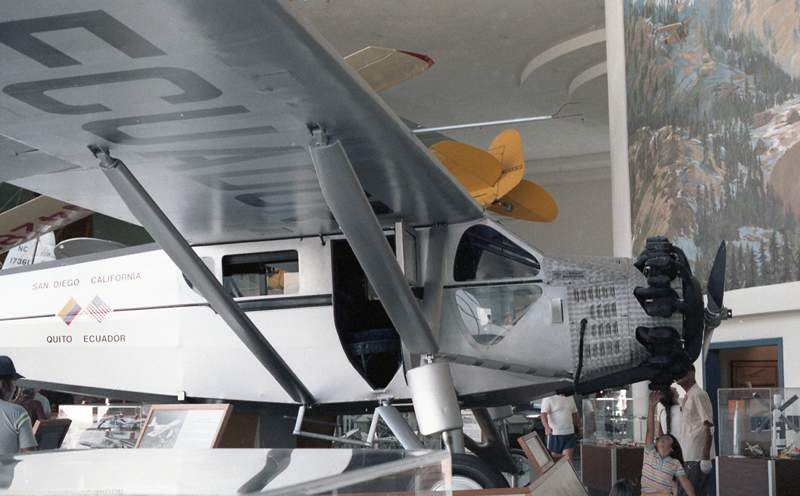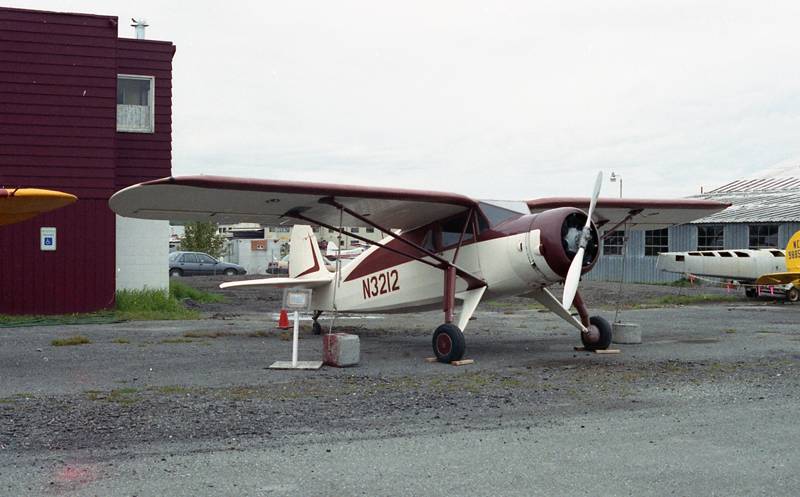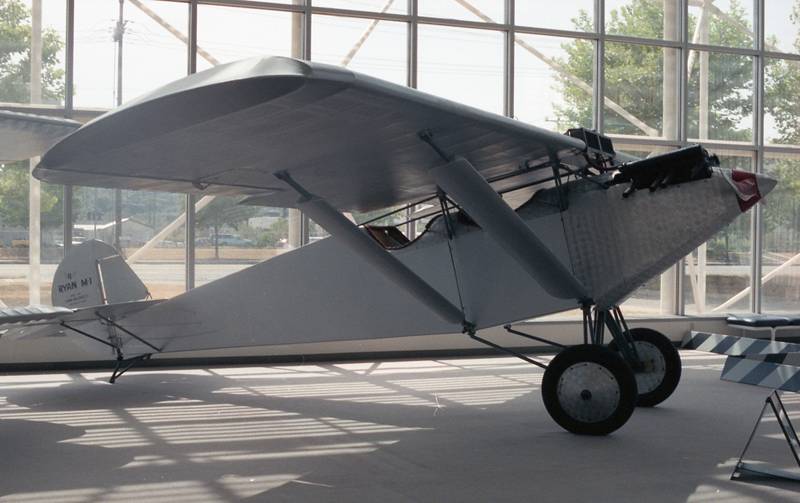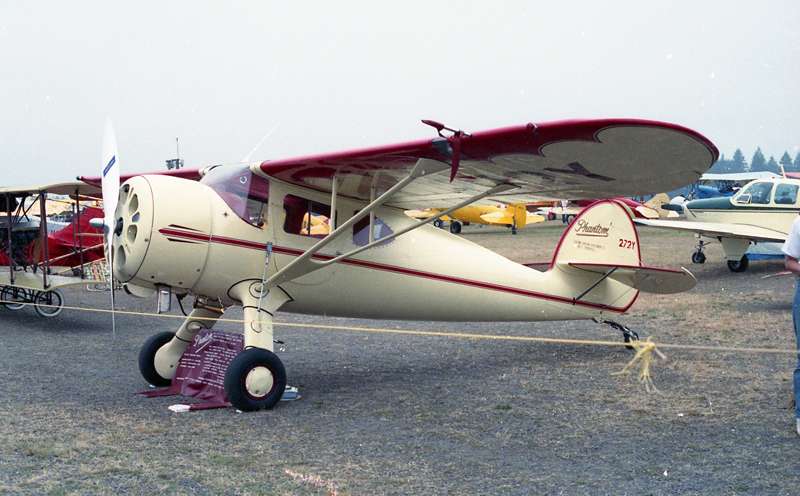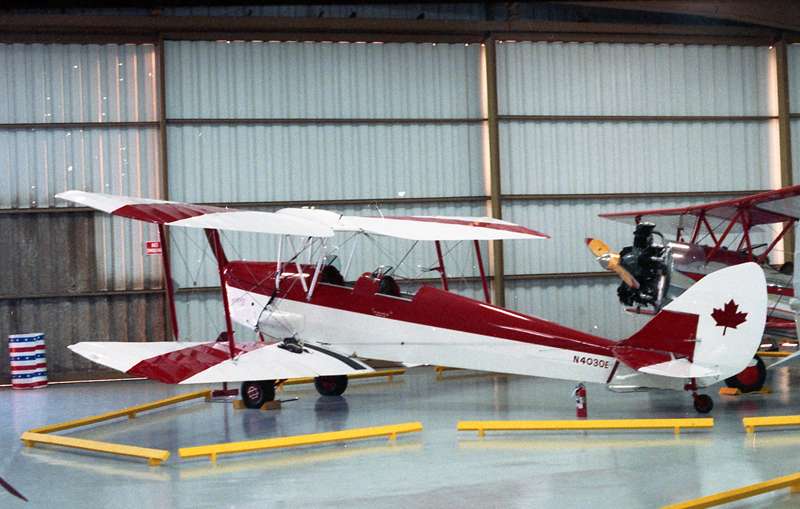The Beechcraft Model 17 Staggerwing is an American biplane with an atypical negative wing stagger (the lower wing is farther forward than the upper wing). It first flew in 1932.
Download Category: Between The Wars
Ryan B-5 Brougham
The Ryan Brougham was a small single-engine airliner produced in the United States in the late 1920’s and early 1930’s. Its design was reminiscent of the M-1 mail plane first produced by Ryan in 1926, and like it, was a high-wing, strut-braced monoplane of conventional design that was a commercial follow-up after the Spirit of St Louis.
Unlike the M-1, the Brougham had a fully enclosed cabin for the pilot and four passengers. The Brougham prototype was derived from the later M-2 and was powered by a 150 hp Hisso engine. The only common parts between the famous Spirit of St. Louis and the first Ryan B-1s were the tail surfaces and a few of the wing fittings. Later B-1 Brougham production versions had no common parts.
This walk-around shows mostly external detail with some internal detail shots.
Walk-Around Information
Number of Images: 74
Resolution: 1200 dpi
Download Type: .zip file
Download Size: 85 Megabytes
Fairchild 24G
The Fairchild Model 24 is a four-seat, single-engine light transport aircraft designed in the 1930s by Fairchild Aviation Corporation. It was adopted by the United States Army Air Corps as UC-61 and also by the Royal Air Force. The Model 24 was itself a development of earlier Fairchild models and became a successful civil and military utility aircraft.
The aircraft was used by small air charter operators for short-distance taxi work and many were acquired by private pilot owners. It served with military forces as diverse as Finland, Thailand, Israel, Canada, the United States and Australia. The last “new” Fairchild 24 was assembled in 1948 from a large inventory of leftover parts in Winfield, KS
This walk-around shows mostly external detail.
Walk-Around Information
Number of Images: 37
Resolution: 1200 dpi
Download Type: .zip file
Download Size: 45 Megabytes
Ryan M-1 Mail Plane
The Ryan M-1 was a mail plane produced in the United States in the 1920s, the first original design built by Ryan. It was a conventional parasol-wing monoplane with two open cockpits in tandem and fixed, tail-skid undercarriage.
This walkaround is all detail shots that are hard to get.
Walk-Around Information
Number of Images: 35
Resolution: 1200 dpi
Download Type: .zip file
Download Size: 44 Megabytes
Stearman C-3B
The Stearman C3 was an American-built civil biplane aircraft of the 1920s, designed by Stearman Aircraft of Wichita, Kansas. It was also the first Stearman aircraft to receive a type certificate.
Walk-Around Information
Number of Images: 51
Resolution: 1200 dpi
Download Type: .zip file
Download Size: 61 Megabytes
Gee Bee Model R-2
The Gee Bee Model R Super Sportster was a special purpose racing aircraft made by Granville Brothers Aircraft of Springfield, Massachusetts at the now-abandoned Springfield Airport (Massachusetts). Gee Bee stands for Granville Brothers. This walk-around is of Delmar Benjiman’s excellent replica. it contains exterior, landing gear, surface detail and cockpit.
Walk-Around Information
Number of Images: 78
Resolution: 1200 dpi
Download Type: .zip file
Download Size: 98 Megabytes
Grumman F3F-2
The Grumman F3F was the last American biplane fighter aircraft delivered to the United States Navy (indeed, the last biplane fighter delivered to any American military air arm), and served between the wars. Designed as an improvement on the single-seat F2F, it entered service in 1936.
About This Subject: Complete walk-around, gear, details, and cockpit.
Walk-Around Information
Number of Images: 24
Resolution: 600 dpi
Download Type: .zip file
Download Size: 2.1 Megabytes
Luscombe Phantom 1 – N272Y
Donald A. Luscombe formed the Luscombe Aircraft Engineering Company in 1933 at Kansas City, Missouri. The Phantom or Model 1 was the first aircraft built by the company, and first flew in 1934. It was a high-wing braced monoplane with conventional fixed tail-wheel landing gear, and was powered by a nose-mounted 145 hp (108 kW) Warner Super Scarab radial engine. The fully enclosed engine cowling, with individual air vents for each cylnder, was unique for a radial engine aircraft. Apart from the fabric wing surfaces, the aircraft was all-metal, and had a luxury interior with two side-by-side seats in an enclosed cabin.
About This Subject: N272Y – 1934, Cream with red trim. Complete walk-around, close-ups, surface details, landing gear and cockpit.
Walk-Around Information
Number of Images: 36
Resolution: 1200 dpi
Download Type: .zip file
Download Size: 23 Megabytes
Vought SB2U Vindicator – 9-B-12
The Vought SB2U Vindicator was a carrier-based dive bomber developed for the United States Navy in the 1930s, the first monoplane in this role. Obsolete at the outbreak of World War II, Vindicators still remained in service at the time of the Battle of Midway, but by 1943, all had been withdrawn to training units. It was known as the Chesapeake in Royal Navy service.
About This Subject
9-B-12 BuNo 1383 – Blue-grey top with light grey underside. Several shots under restoration, photos with wings both folded and with them down. Several overhead balcony shots and full walkaround, gear, some surface detail, no cockpit.
Walk-Around Information
Number of Images: 53
Resolution: 1200 dpi
Download Type: .zip file
Download Size: 13.2 Megabytes
WACO YMF-5 – N40116
Originally produced between 1934-1935 by the WACO Aircraft Company of Troy, Ohio, the WACO YMF-5 has been regarded as the finest open cockpit sport biplane ever built. With its clean lines showing off its classic biplane shape and its powerful 275 HP radial engine, this current production American built 3 person luxury biplane captures the essence of what flying is all about: Magic, Beauty, Adventure and Romance.
Production of the WACO YMF was re-established in 1986 by the Classic Aircraft Corp in Lansing, MI, many updated features were integrated into the design without taking away from the original heart and soul of the aircraft.
About This Subject
N40116 s/n F5-024 – Red and black with gold trim, “Mad Dog”, complete walk around, gear, wheel pants, surface detail, and cockpit.
Walk-Around Information
Number of Images: 74
Resolution: 1200 dpi
Download Type: .zip file
Download Size: 18.6 Megabyte
de Havilland DH.82 “Tiger Moth” – N4030E
The de Havilland DH.82 Tiger Moth is a 1930s biplane designed by Geoffrey de Havilland and was operated by the Royal Air Force (RAF) and others as a primary trainer. The Tiger Moth remained in service with the RAF until replaced by the de Havilland Chipmunk in 1952, when many of the surplus aircraft entered civil operation. Many other nations used the Tiger Moth in both military and civil applications, and it remains in widespread use as a recreational aircraft in many countries. It is still occasionally used as a primary training aircraft, particularly for those pilots wanting to gain experience before moving on to other tailwheel aircraft, although most Tiger Moths have a skid. Many are now employed by various companies offering trial lesson experiences. Those in private hands generally fly far fewer hours and tend to be kept in great condition.
About This Subject
N4030E – Red and while with Maple Leaf on rudder, complete with cockpit shots.
Walk-Around Information
Number of Images: 43
Resolution: 1200 dpi
Download Type: .zip file
Download Size: 52.1 Megabytes
Curtiss C-1 Robin – NX979K
The Curtiss Robin, introduced in 1928, was a high-wing monoplane with a 90 hp (67 kW) V8 OX-5 8-cylinder engine built by the Curtiss-Robertson Airplane Manufacturing Company. It was later fitted with the more powerful Challenger engine, which developed between 170 and 185 hp (127 and 138 kW). NOTE: Model B (90 hp/67 kW Curtiss OX-5 engine), Model C-1 (185 hp/138 kW Curtiss Challenger engine), and Model J-1 (165 hp/123 kW Wright J-6 Whirlwind 5 engine)
About This Subject
1929 NX979K, s/n 628, Red with yellow wings, full exterior walk-around, no full interior shots.
Walk-Around Information
Number of Images: 31
Resolution: 1200 dpi
Download Type: .zip file
Download Size: 37 Megabytes
Waco UPF-7 – NC29102
The Waco UPF-7 is an unusual airplane. Not due to any outstanding technical features but to timing. A relatively obsolete design, it was built in quantity at a time when the open cockpit biplane trainer for civilian use was virtually extinct. Even then, it slipped into service unnoticed since it had no significant new features to arouse the aviation community
Production of commercial biplane trainers virtually ended in Depression years of the early 1930s, and new low-powered monoplanes rapidly took their place in the schools and in private aviation. Only the Army and Navy were principal customers for biplane trainers in succeeding years. While Waco did not have a share of this market, it was one of the few firms that continued to supply open cockpit biplanes to private owners of the mid-1930s, a group comprising what could be considered a custom trade. Yet the UPF-7, introduced in the late twilight of the biplane era, was built in greater quantity than any single Waco model that preceded it. Approximately 600 came out of the Troy, Ohio factory between 1937 and 1942.
Walk-Around Information
Number of Images: 76
Resolution: 1200 dpi
Download Type: .zip file
Download Size: 103 Megabytes
Ryan PT-22 Recruit – N47843
The Ryan PT-22 Recruit, the main military version of the Ryan ST, is a military trainer aircraft used by the United States Army Air Corps and its successor, the United States Army Air Forces for primary pilot training. It was the first monoplane that the Army had used for primary pilot training, as all previous PT aircraft were biplanes.
Walk-Around Information
Number of Images: 48
Resolution: 1200 dpi
Download Type: .zip file
Download Size: 63 Megabytes
de Havilland DH.94 Moth Minor – N94DH-AV977
The Moth Minor was designed as a low-wing monoplane to replace the biplane Moth series, intended to give similar performance on lower power, and not requiring rigging. The wooden prototype of the DH.94 was first flown by Geoffrey de Havilland on 22 June 1937 at Hatfield Aerodrome. Production started and nearly 100 examples had been built by the outbreak of World War II. With a selling price of only £575 the Moth Minor was popular with flying clubs keen to acquire modern monoplanes.
Civil aircraft operated in the United Kingdom were impressed into wartime service with the Royal Air Force and Fleet Air Arm, one example was used by the United States Army Air Corps. A large number of civil aircraft from the UK were sent to Australia, where they and a handful of locally-built Australian civil aircraft were impressed into the Royal Australian Air Force.
Walk-Around Information
Number of Images: 70
Resolution: 300 dpi
Download Type: .zip file
Download Size: 184 Megabytes
de Havilland DH.94 Moth Minor – GAFPN
The Moth Minor was designed as a low-wing monoplane to replace the biplane Moth series, intended to give similar performance on lower power, and not requiring rigging. The wooden prototype of the DH.94 was first flown by Geoffrey de Havilland on 22 June 1937 at Hatfield Aerodrome. Production started and nearly 100 examples had been built by the outbreak of World War II. With a selling price of only £575 the Moth Minor was popular with flying clubs keen to acquire modern monoplanes.
Civil aircraft operated in the United Kingdom were impressed into wartime service with the Royal Air Force and Fleet Air Arm, one example was used by the United States Army Air Corps. A large number of civil aircraft from the UK were sent to Australia, where they and a handful of locally-built Australian civil aircraft were impressed into the Royal Australian Air Force.
Walk-Around Information
Number of Images: 35
Resolution: 230dpi
Download Type: .zip file
Download Size: 12 Megabytes

